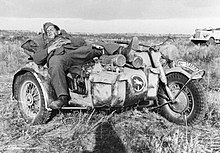Troop registration numbers of the Wehrmacht and Waffen-SS

German troop badges , also known as division badges, are symbols and signs that were used by associations of the Wehrmacht and Waffen-SS during World War II and were applied to vehicles and equipment.
Troop registration plates are not to be confused with the tactical symbols (organizational affiliation) on vehicles.
The Air Force used similar emblems on their aircraft, and occasionally on their vehicles and equipment - they are called federation badges .
Emergence
Even before the Second World War, some units were marked accordingly. As a trial from May 1939, troop registration numbers for the motorized infantry divisions were introduced at the beginning of the war. With the experience of the attack on Poland , license plates were also introduced for the vehicles of the armored divisions ( High Command of the Army (BdE) No. 5729/39 go. AHA / In 6 IIIa of November 1, 1939). These were applied with yellow paint and should not exceed a maximum size of 100 × 100 mm.
After the official recognition, the marks were only allowed to be used by associations in the field. With order no. 21 of February 16, 1944 (OKH Gen St d H Org Abt. II / 31 180/44) they were finally legitimized.
use
The troop identifiers were applied to vehicles, guns, signs, etc. and were intended to enable their own troops to recognize and find the units.
The large number of German military units in World War II produced a corresponding number of troop plates.
Comparable marks on air force aircraft are squadron, group, squadron and staff badges.
layout
Troop labels were created by the units themselves, for example in competitions. The signs and symbols used reflect a certain self-image, a geographical origin of your home location is also possible or a reference to the area of application. Often animal or plant motifs, mythical creatures, characters from legends and fairy tales were chosen, whose properties should reflect the spirit of the units. Lucky charms such as pigs, keys, shamrocks and horseshoes were also used. Many troop marks are in the form of coats of arms and bear heraldic motifs. Stylized characters or runes also found their way into the symbolism of the troop marks.
meaning
Troop identification not only served to identify own units and for orientation, but also strengthened the feeling of togetherness.
The troop identification enables research to assign individual troop units based on photos.
See also
literature
- W. Fleischer, “Troop Identification of the German Army and Air Force”, Dörfler-Verlag 2002, ISBN 3895554448
- P. Schmitz, KJ Thies “The troop numbers of the associations and units of the German Wehrmacht and Waffen SS in World War II. Volume 1: Das Heer “, Biblio-Verlag 1987, ISBN 3-7648-2477-8
- P. Schmitz, KJ Thies “The troop numbers of the associations and units of the German Wehrmacht and Waffen SS in World War II. Volume 2: Marine, Luftwaffe, Waffen-SS “, Biblio-Verlag 1987, ISBN 3-7648-1498-5
- P. Schmitz, KJ Thies “The troop numbers of the associations and units of the German Wehrmacht and Waffen SS in World War II. Volume 3: Supplements to Army - Navy - Air Force - Waffen-SS “, Biblio-Verlag 1991, ISBN 3-7648-2401-8
- P. Schmitz, KJ Thies “The troop numbers of the associations and units of the German Wehrmacht and Waffen SS in World War II. Volume 4: New additions, additions, corrections to the command authorities of the Army - Air Force - Waffen-SS and Infantry - Rapid Troops ”, Biblio-Verlag 2000, ISBN 3-7648-2405-0

